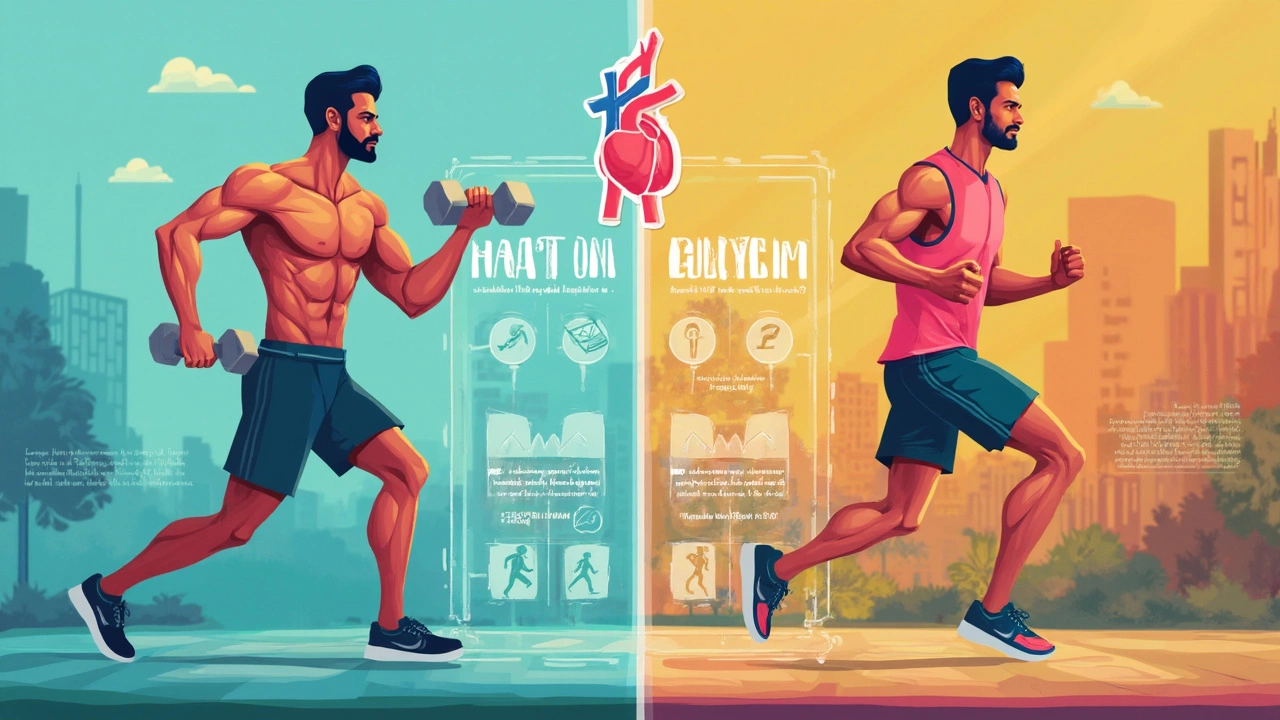What Happens If You Only Lift Weights and Skip Cardio?
 May, 23 2025
May, 23 2025
So, you want to skip the treadmill and go straight to the dumbbells? You’re not alone—lots of people can’t stand running or cycling and would rather focus on building muscle. The question is, can you get away with just lifting weights and never lacing up for cardio?
When you only do strength training, your muscles definitely grow. Lifting heavy is awesome for looking toned, building strength, and even burning fat. But here’s where things get tricky—your heart is a muscle too, and it craves a different type of workout. Cardio doesn’t just help you lose weight; it builds up your heart and lungs so they can supply your bigger muscles with more blood and oxygen while you live your life outside the gym.
Let’s be real: if your only activity is lifting, you might notice you get winded climbing stairs or chasing after your dog. That doesn’t mean weightlifting is bad or useless—it just means you could be missing out on some sneaky benefits that cardio brings. And if you’re hoping to avoid health issues down the line, ignoring your heart isn’t the best bet.
- Muscle Gains vs. Heart Health
- How Your Body Changes Without Cardio
- Energy, Endurance, and Everyday Life
- Balancing Strength and Cardio: Tips That Work
Muscle Gains vs. Heart Health
Lifting weights is hands-down one of the best things you can do to build muscle and strength. If you want to get stronger, look more defined, or boost your metabolism, resistance training has your back. Regular strength training actually helps you hold onto muscle as you get older—which is pretty awesome for your long-term health and the way you look.
But here’s something a lot of people overlook: Your heart needs just as much attention as your biceps. Lifting weights works your muscles, but it doesn’t give your heart the sustained challenge it gets from cardio. That’s because strength training raises your heart rate in short bursts, not for long stretches. Cardio, on the other hand, keeps your heart pumping for longer, so it gets stronger and more efficient.
Skipping cardio can leave your heart (and lungs) a bit behind, even if your arms look amazing. Studies show that regular cardio cuts your risk of heart disease, high blood pressure, and stroke. Lifting helps, but it’s simply not enough for full-on heart health. To get a better idea of what both training styles do, here’s a quick side-by-side:
| Effect | Weight Lifting | Cardio |
|---|---|---|
| Muscle Growth | High | Low |
| Fat Loss | Moderate | High (especially with diet) |
| Resting Heart Rate Improvement | Some | Significant |
| Blood Pressure Control | Some | Significant |
| Endurance | Low | High |
What jumps out? Lifting is fantastic for muscle, shape, and even some fat loss, but cardio takes the win for heart health and endurance. That doesn’t make one better than the other—they just work different parts of your body. If you’re all about lifting, know your ticker won’t get all the love it needs from weights alone.
How Your Body Changes Without Cardio
Most people picture bigger arms or a defined back when they think of weightlifting, but what’s happening under the surface if you cut out cardio completely? For one, your heart and lungs aren’t working as hard during strength workouts as they do when you’re huffing through a run. So even as you get stronger, your cardiovascular fitness might lag behind.
Skipping cardio can affect your resting heart rate and blood pressure. Regular aerobic exercise helps your heart pump blood more efficiently. Without it, you might see numbers creep up at your next physical. The American Heart Association says adults should aim for at least 150 minutes of moderate-intensity cardio a week for good heart health, but that doesn’t happen just from strength training alone.
You might also notice your overall stamina goes down. Sure, you can lift heavy things in the gym, but things like walking long distances, taking stairs, or even playing with your kids might feel tougher. Your body adapts to what you ask it to do most, so without regular cardio, endurance can take a hit.
- Cholesterol and blood sugar levels might not improve as much, since cardio helps manage both.
- Fat loss can slow down, especially if you rely on quick, heavy lifts. Cardio often burns more calories per minute.
- People who only lift sometimes feel more sore or rundown because there’s less oxygen moving through the body after intense sessions.
There’s some good news—if you really don’t like running, you don’t have to force it. Simple things like brisk walking, cycling, or even active chores can give your heart a boost. Just keep in mind: getting the most out of your workouts often means including both strength training and some kind of cardio in your week.

Energy, Endurance, and Everyday Life
Lifting weights does a great job at making you stronger, but it doesn’t do much for stamina. Without regular cardio, you’re likely to notice that you run out of gas in day-to-day situations—things like walking quickly between subway stops, running after kids, or playing a pick-up game of basketball catch up with you fast. Your energy just isn’t built up the same way it would be with some intentional cardio in your mix.
Here’s the kicker: strength training relies on short bursts of effort, while cardio builds up your ability to keep moving without resting. Endurance activities train your heart to pump more blood with less effort, and your body learns to use oxygen more efficiently. If you skip cardio, you might crush heavy sets in the gym but get tired taking the groceries up a couple of flights of stairs. That’s not exactly the trade-off most people want.
The American Heart Association puts it clearly:
"Regular physical activity helps improve overall health, fitness, and quality of life. It also reduces your risk for chronic conditions like heart disease, type 2 diabetes, and some cancers."That’s practical stuff most of us care about every single day.
People who only lift often realize their endurance lags behind. You feel strong during short bursts, but long walks or any activity that takes more than a minute of moderate effort starts to feel like a marathon. Add to that, most daily tasks use a mix of muscle strength and cardiovascular fitness. You want both on your side.
- If you’re gasping by the time you reach the third floor, it’s not your muscles failing you—it’s your lungs and heart wishing you’d hop on the bike sometimes.
- Better blood flow thanks to cardio means your muscles recover faster between heavy lifts, so you can actually make more progress in the gym by adding a little cardio.
- Without any cardio, your risk for high blood pressure and cholesterol creeps up, which can leave you feeling sluggish long before you see any visible health problems.
If you love weights and can’t stand the treadmill, even small tweaks work. Take the stairs, walk briskly on your lunch break, kick around a soccer ball with friends, or try a quick HIIT session here and there. You’ll notice more pep in your step, in and out of the gym.
Balancing Strength and Cardio: Tips That Work
You don’t have to run marathons to get the best of both worlds. Blending strength training and some cardio can seriously boost your results. It doesn’t have to be complicated or time-consuming, and you can fit it right into your week, even if you’re busy.
If you lift weights three or four days a week, just add two short cardio sessions, maybe 20-30 minutes each. Walking counts, and so do brisk jogs, cycling, or even a dance class. You don’t have to turn into a cardio addict. High-intensity intervals work too—the kind where you push hard for a minute, rest, and repeat. A 2019 study in Medicine & Science in Sports & Exercise found that just two HIIT sessions a week can improve heart health without messing with muscle gains.
Here are some simple ideas for combining both:
- Do ten minutes of rowing or incline treadmill after your lifting session.
- Try a circuit workout—alternate lifts with short bursts of jumping jacks or mountain climbers.
- Walk or bike to the gym if you live close by, turning it into a warm-up/cool-down.
- On rest days from lifting, go for a hike, fast walk, or swim—something you actually enjoy.
If you hate cardio, pick music or podcasts to distract yourself, or do it with a friend. What matters most is sticking to it, so you don’t have to dread every second. And honestly, feeling yourself get less winded during everyday stuff is super motivating—it makes sticking with your routine way easier.
Bottom line? You’re not giving up muscle by blending in cardio here and there. You’re getting stronger, living healthier, and making sure that all that hard work in the weight room pays off in real life too.
